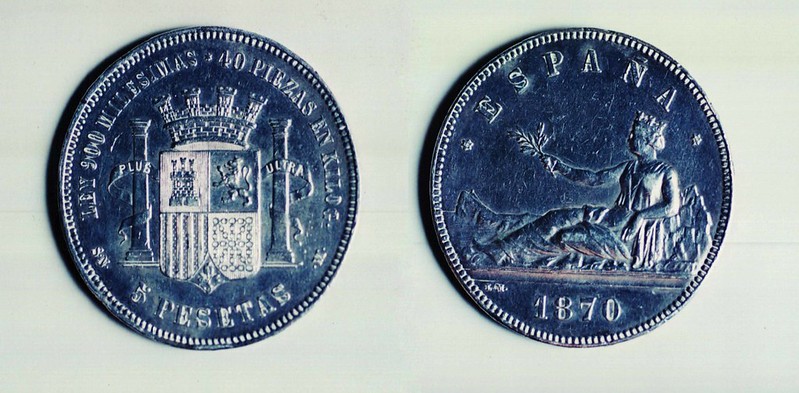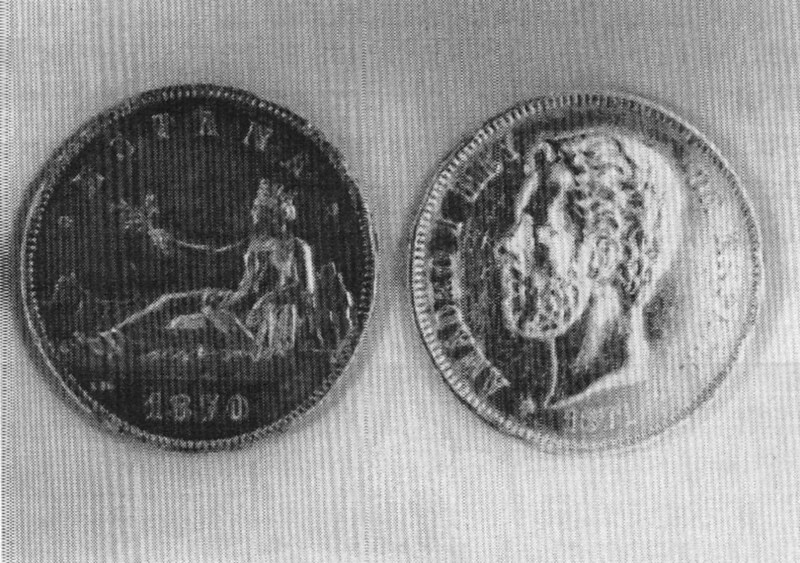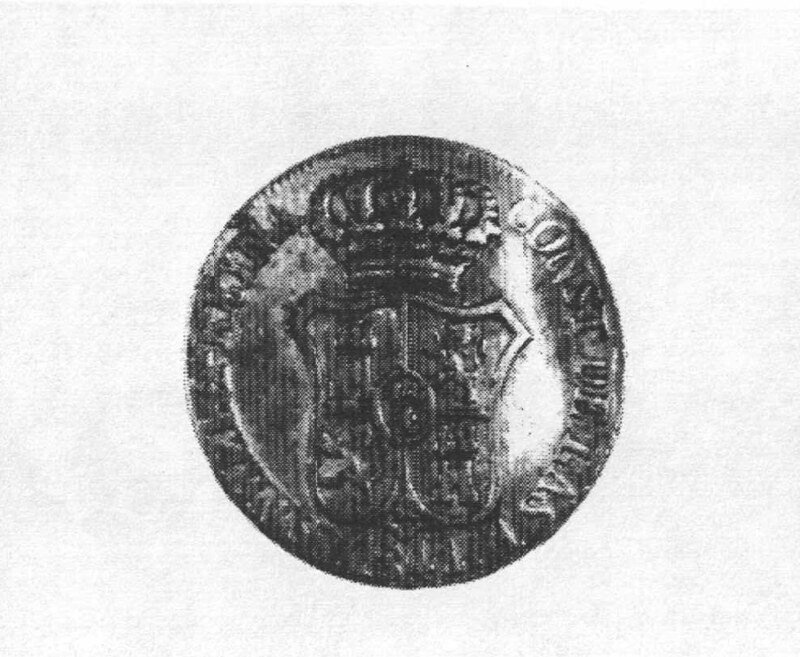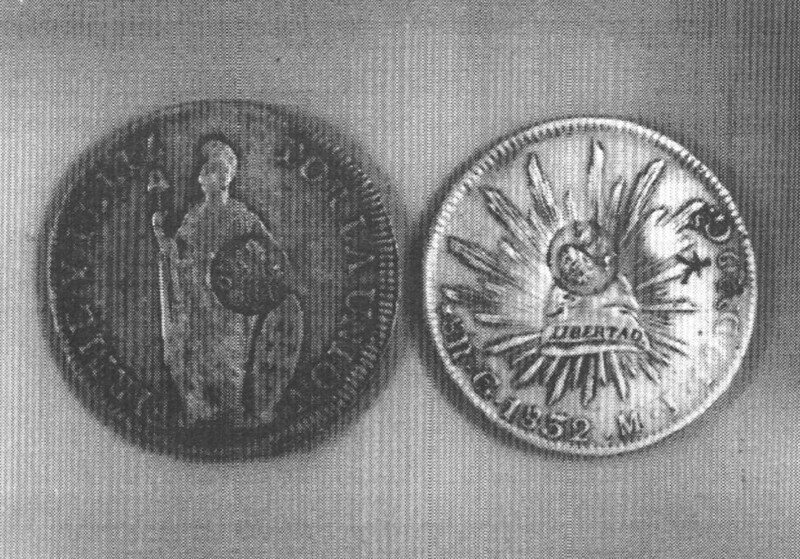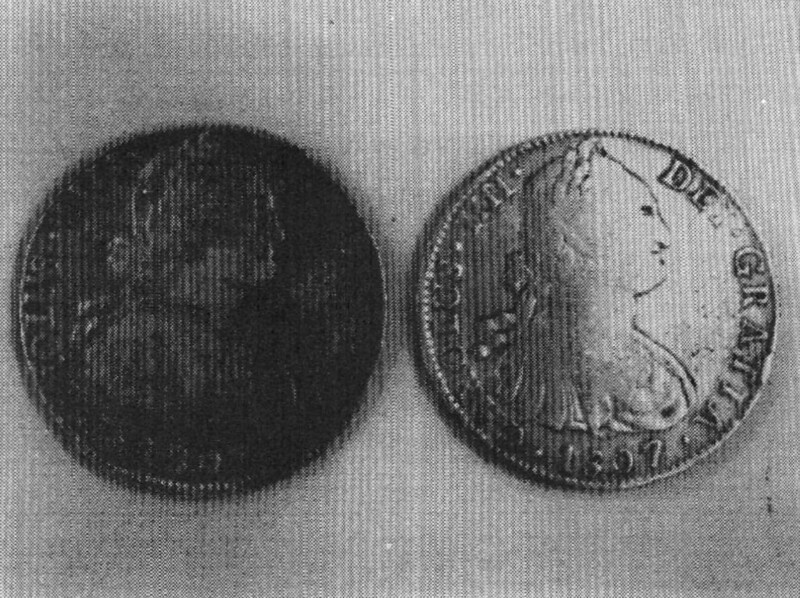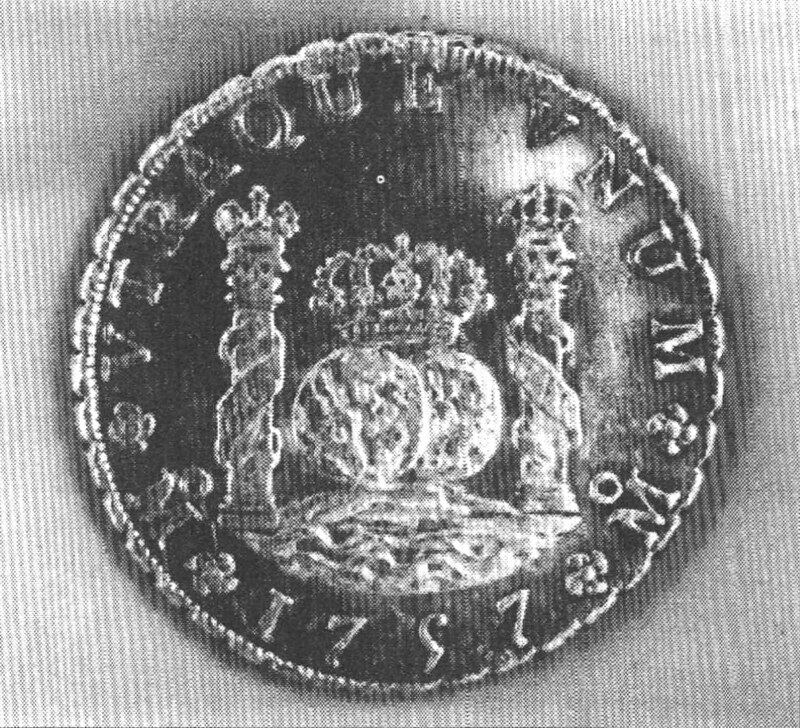Spanish Coinage in Guam
The early years
A method of barter was in common use by native CHamorus long before the Spaniards arrived in Guam in the 16th century. Because of this barter system and the absence of commerce, there was no need for a coinage system in Guam during the first 150 years of Spanish rule. Coin usage was slow to develop and can be linked to the development of Guam as a Spanish colony, to historical events, and to coinage policies established by Spanish officials in Spain, Mexico, Guam and the Philippines.
After Father Diego Luis de San Vitores established the first mission in 1668, a Spanish galleon usually stopped in Guam once a year on its way from Acapulco to Manila to trade with Chinese merchants. Each of these galleons brought additional personnel, primarily clergy and soldiers as well as individuals who were designated by Spain to rule and administer the far-flung colonies of Guam and the Philippines.
These galleons also off-loaded animals at either Humåtak Bay or Hagåtña (Apra Harbor) and delivered the “situado” for Guam’s Spanish colony. The “situado” included clothing and silver coinage that comprised salaries for the governor and the troop commander, payroll for the soldiers, and stipends for the missionaries. Since there were no stores in Guam during the early years, soldiers often gambled their silver wages away.
Cobs and pieces of eight
Spanish galleons on the Acapulco-Manila trade route carried silver coinage not only to deliver the “situado” to the colonies in Guam and the Philippines but also to have silver available for trade with the Chinese merchants in the Asia. The silver coinage transported by the galleons consisted primarily of “pieces of eight,” the common slang name for Spanish and Spanish-American 8-reales silver coins. Although the coins were produced between 1500 and 1900, their transport by Spanish galleons between Mexico and the Philippines was limited to the period between 1565 and 1815.
The Spanish and Spanish-American 8-reales coins were called “pieces of eight” because they were often divided into eight equal parts (called “bits”) for small change. Each bit was worth one Spanish “real” or twelve and one half US cents. These 8-reales coins were also divided into quarters or four equal parts (called “two bits”). Each “two-bits” piece was worth two reales or twenty-five US cents.
During the reign of Ferdinand and Isabella, a royal decree in 1497 declared the “real” as the official Spanish monetary unit. Although the first 8-reales coins were struck in Spain in about 1500, most were produced in Spanish-America, especially in Mexico. The Mexico City and Peru mints struck 8-reales coins for the first time in 1572 during the reign of Philip II. These first pieces were called cobs and were irregular in shape. The word cob is derived from the Spanish “cabo de barra” which means “end of the bar.”
Each cob is unique as no two cobs have the same shape or thickness, nor do they bear the same imprints. However, cobs have the same weight. Each weighed 27.4680 grams from the time they were first made up to the year 1728, and 27.0642 grams thereafter. The cobs were crudely cut from refined silver bars, each with a cross stamped on one side and the Spanish royal coat of arms stamped on the other. After metal blanks were cut from a silver bar, each blank was trimmed to the exact weight and then heated so that it would be soft enough for striking. The silver blank was then placed on one die and a second die was placed over the blank and struck with a hammer, impressing a design on each side of the coin.
Spain advocated the manufacture of cobs for two reasons. First of all, because of the abundance of silver ore in Spanish-American colonies, silver coins were minted in these colonies; however, the workmanship at the Spanish-American mints was considered crude. The second reason was that cobs provided a convenient and measurable method by which silver bullion could be transported from one corner of the Spanish empire to another, especially since each cob was of the same precise weight.
Conventional circular silver 8-reales coins were produced in Spain (Madrid and Seville) and in six Spanish-American colonies (Bolivia, Chile, Colombia, Guatemala, Mexico and Peru). The best known Spanish dollar during the 18th century was the “pillar dollar,” a Spanish milled dollar which was minted in Spanish-America (between 1732 and 1760) to replace the cob. The reverse side of the coin bears two identical pillars which represent the Pillar of Hercules, two rock projections at the Strait of Gibraltar. The “pillar dollar” was considered a standard of trade and was not only used in Spain’s colonies but was also used in the United States well into the 19th century. Two, one, and one-half reales coins were also circulated during the 18th century.
Bolivia also minted (between 1801 and 1825) an 8-reales coin worthy of note. This coin bears a PTS mint mark which stands for Potosi, an imperial city which was founded in 1546. Potosi was located in the midst of the world’s richest silver mines which produced in excess of 2 billion dollars worth of silver. An 8-reales piece minted in Bolivia is displayed in the Guam Museum. It is surmised that this 8-reales coin was brought to Guam as part of the “situado” as the last Spanish galleon stopped over in Guam in 1815.
The Acapulco-Manila trade route traversed by the galleons came to an end in 1815 because of the Mexican revolution. Consequently the “situado” for the colony in Guam was drastically reduced as Spain no longer had access to the silver mines in Mexico. Spanish ships continued the trade with merchants in the far east by crossing the Indian Ocean.
The Pilar
In the latter part of the 17th century, one of the more significant events was an aborted stopover by two galleons transiting from Acapulco, the Santo Nino and her escort, the Nuestra Senora Del Pilar De Zaragoza, or Pilar. The Flagship Santo Nino was carrying the “situado” for the Marianas and at the same time, was transporting Governor-General Fausto Cruzat y Gongora to his new post in the Philippines. The Pilar, meanwhile, was transporting several Franciscan missionaries and a large contingent of soldiers, including numerous convicts, from New Spain to the Philippines.
On 3 June 1690 while the Pilar was approaching Humåtak Bay, strong currents caused her to veer off course and to run aground on reefs off Cocos Island, which ships must circumvent while proceeding into the bay. The 300 people aboard the Pilar abandoned ship and were rescued. The high-ranking passengers were embarked aboard the Santo Nino while the others were ferried ashore to await the next visiting ship. Because of the mishap, the commanding officer of the Santo Nino did not want his ship to share the Pilar’s fate and proceeded to the Philippines without off-loading the “situado”.
It is estimated that the Pilar was transporting 1,500,000 coins. These silver coins were packed in chests containing 2,500 to 3,000 coins apiece, each weighing about 160 pounds. The chests were stored low in the Pilar and used as ballast to keep the galleon stable while sailing. An organization called Pilar Project Limited commenced salvage recovery of the Pilar wreck in 1986 and has continued this operation to the present day on an intermittent basis, To date, fewer than one hundred coins have been recovered from the Pilar. Other articles recovered include cannon balls, musket balls, and religious artifacts.
Wages for CHamorus
Before the introduction of coinage, the CHamorus were compensated for their labor by various means. For example, between 1680 and 1720 a CHamoru was paid a day’s work with two or three leaves of tobacco grown in the Philippines. However, these tobacco leaves were priced at double their value. This double valuation depressed a CHamoru’s daily wage which was equivalent to about one-tenth of a “real”, about one-eightieth of a silver peso. In terms of buying power, a single pair of trousers made of the cheapest material cost between six to eight reales. Hence a CHamoru had to work four to six months in order to acquire a pair of trousers.
Introduction of coinage
In the early 1700s, the Superior Government of Manila issued a document that recommended, in part, that coinage be introduced into the Marianas since the lack of currency was supposedly the principal cause of certain problems or ills that needed correction. In 1706, the Very Reverend Gerardo Bowens, S J, Vice Provincial of the Marianas’ Mission, commented on the document and indicated that it was not clear to him how such ills as oppression and injustice could be corrected by introducing coinage. The reverend father went on to state that the oppression and injustices inflicted on the CHamorus could be corrected by not working them excessively, not abusing them, and by not compensating them with money, but with items such as “bolos” (machetes), “carajayes” (iron frying pans) and other tools and ornaments that would be of use to them.
The attempt to introduce coinage into Guam in the early 1700s was unsuccessful. Coinage was eventually introduced into Guam but not because it was mandated by government officials in Manila, but because of the start-up of various economic activities as well as the need for a medium of exchange as Guam’s contacts with the outside world increased primarily through the Philippines. There were frequent personnel transfers and visits (involving Spaniards, Filipinos, Mexicans, and South Americans) between the Philippines and Guam while supplies for the colony in Guam also often came from the Philippines.
And last but not least, Guam was initially ruled as a colony separate from the Philippines but its administration was transferred from the Viceroy of Mexico to the Governor-General of the Philippines in 1817. Because of these links between Guam and the Philippines, it can be deduced that the coinage used in the Philippines was also used in Guam during the Spanish era. Although Spain and the Philippines played dominant roles in introducing coinage into Guam, visiting ships from other countries also imported money into Guam.
Counter-stamped coins
The first coinage used by the general populace on a large scale in both colonies were counter-stamped coins. On 31 October 1828, the Governor-General of the Philippines inaugurated the counter-stamping of Spanish-American coins during the reign of Spain’s Ferdinand VII (1808 to 1833). Use of the first counter-stamps (between 1828 and 1830) was politically rather than economically motivated.
Because of the numerous coins minted in the newly formed republics such as Mexico, Bolivia and Peru that bore slogans pertaining to freedom and liberty, Spanish officials became concerned regarding the influence these coins would have on their subjects in their colonies in the Philippines and Guam. Hence, the early counter-stamps were serrated designs that were intended to obliterate the lettering around the rims of coins from the former Spanish-American colonies. King Ferdinand’s counter-stamp “F.7” was implemented in 1830. This counter-stamp was retired in 1834 after the death of Ferdinand VII and was replaced by “Y-II”, a counter-stamp for Isabel II, Spain’s monarch from 1833-1868.
Consequently, during the period 1828 to 1837, foreign money was imported into Guam and the Philippines from the insurgent republics of Spanish-America (primarily Mexico, Bolivia and Peru). Large quantities of silver coin were counter-stamped by Spanish officials in Manila as “coin of the realm”. The Mexican 8-reales piece was the predominate coin counter-stamped. Note that silver coins became Philippine colonial coinage upon being counter-stamped. Many of the coins counter-stamped by the Spaniards also bore chop marks. A chop mark was a counter-stamp by either a Chinese merchant or banker. The Chinese placed chop marks on silver coins as a defense against counterfeit coins as a chop mark authenticated a coin as being genuine.
Economic activities
The use of the counter-stamped coinage in Guam coincided with a period of economic reform instituted by Governor Francisco Ramon de Villalobos (1831 to 1837). Villalobos established new economic policies that allowed for private enterprise. For example, he implemented the collection of port fees from visiting ships and initiated the production of articles for export including dyewood, indigo, turtle shell, mother-of-pearl, and arrowroot. Additionally, Villalobos changed the name of the “governor’s store” (which had been in existence since the late 17th century) to “government store” and discontinued the governor’s monopoly on the store.
Port visits by whaling ships (primarily American and British) also spawned economic activity. Starting in 1823, whalers stopped in Guam for thirty or more days for ship repairs, to take on water and provisions, and for rest and recreation. Approximately thirty to sixty whalers stopped in Guam and Saipan each year. Each whaling vessel spent about 600 pesos during each port visit and the whalers expended a total of 40,000 pesos per year. Selling provisions, “aquardiente” (locally distilled liquor), other local products, imported articles and providing entertainment to the whalers were the primary sources of income for local residents during the 1840s.
The commercial activity generated by the whalers was short lived, however. It lasted only thirty years (between the 1820s and 1850s) as the whaling vessels switched their port visits to New Zealand and Hawaii in order to follow the whale to other feeding grounds.
Period of uncertainty
Spanish officials issued an order to halt the counter-stamping of foreign coins in 1837. Consequently, confusion resulted as there was no uniformity in the coinage being circulated. During the period 1837 to 1861, Spanish American coins were used alongside Spanish maravedis, quartos and pesetas. Maravedis are copper coins that were minted in Spain. Thirty-four maravedis is equivalent to one “real”. The quartos are copper coins that were manufactured in the Philippines by Chinese contractors and were used as colonial currency in both the Philippines and Guam. Four quartos are equivalent to one “real”.
An interesting coin that was minted in Spain during this period is the duro, a silver coin that was valued at 20 reales. Transactions involving the duro are described in Governor Luis de Ibanez y Garcia’s “History of the Marianas, Caroline and Palau Islands” which was written in 1886. Ibanez-Garcia describes a conversation between a CHamoru and a Spaniard who had just arrived in port. While being transported by boat from ship to shore, the visitor inquired as to the cost of the boat ride. The CHamoru replied, ” a half duro”. The CHamoru also informed the Spaniard that transportation between Piti and the capital city of Hagatna, a distance of two Spanish leagues (about seven miles), would cost three and a half duros-two and a half for a wagon, and one duro for a horse. Both coins bear the bust of Isabella II.
Royal mint
In 1857, a royal decree by Queen Isabel II provided for the creation of a Royal Mint in Manila. A second decree in 1861 called for the removal of Spanish-American silver coins from circulation and provided for new silver coinage as well as gold to be made at this mint. Between 1861 and 1868, gold was coined in three denominations-4 pesos, 2 pesos, and 1 peso. Each denomination bears the bust of Isabella II. A second series of 4-pesos gold pieces was minted between 1880 and 1885. Each of these 4-pesos coins bears the bust of Alphonso XII.
Silver Coinage by the Manila mint began in 1864 with three denominations-10, 20, and 50 centimos. The only indication that these coins were intended for circulation in the Philippines and Guam was their valuation-not in Spanish reales, pesetas, or escudos, but in fractions of a Philippine peso. Like the gold coins, the silver coins were produced by the royal mint until the 1880s. There were two series of silver coins minted. The first series (1864 to 1868) bears a bust of Isabella II on the front of each denomination, while a bust of Alphonso XII adorns the front of each denomination of the second series (1880 to 1865). Although Spanish-American coins were removed from circulation by royal decree, coins from Spain per se were still used alongside Philippine coinage minted in Manila. One such coin is a 5-peseta silver coin minted in Madrid in 1870 and is displayed in the Guam Museum.
Mexican silver pesos
The most important commodity available to Europeans for trade with Chinese merchants was silver. The great majority of silver coins used for exchange came from Spanish-America-primarily from Mexico, Bolivia and Peru. The preferred coin was the Mexican peso which the Chinese referred to as “Dollar Mex”. This coin was so highly thought of that in 1876, Spanish officials authorized Mexican silver pesos to be circulated at par with Philippine gold pesos. These silver coins were by far the most frequently used medium for exchange in the Philippines and Guam. They were part of the Mexican Liberty Cap series. The liberty cap on the front of the coin is a symbol of freedom dating back to ancient Rome. The coin bears a liberty cap within a glory of rays and starting in the early 1920s, began representing Mexico’s freedom from Spain.
Last silver peso
In 1897, the mint in Madrid made a large quantity of Philippine silver pesos. The words “Isles Philippines” were inscribed on the reverse side of the coin. These silver pesos were the last coins minted for use in the Philippines and Guam before the Spanish-American War. These coins were used in Guam until 1900 when Mexican coin or the American equivalent became the legal tender of Guam. They remained in circulation in the Philippines until 1904 when the US Civil Governor in Manila declared that they would no longer be accepted as legal tender after 30 September of that year. Additional Philippine coinage used during the latter part of the century includes 10-centimos, 20-centimos, and 50-centimos pieces.
Spanish-American War
In early June 1898, an expeditionary squadron under the command of Captain Henry Glass stopped in Hawaii to take on coal, water, and provisions. The squadron consisted of the cruiser Charleston which served as the flagship and three transports, Australia, City Of Peking and City Of Sydney. The squadron got underway on 4 June 1898 and 24-hours later, Captain Glass opened and read his sealed orders in the presence of the crew. He was directed to proceed to the island of Guam to capture the island. Upon the capture of Guam, the squadron was to proceed to the Philippines to reinforce Commodore George Dewey.
On 1 May 1898, Dewey had steamed into Manila Bay and had sunk the Spanish Fleet. His forces also captured Cavite Naval Base and Corregidor Island. The troops being transported by Glass’ squadron were the first reinforcements for Dewey’s forces.
USS Charleston
On 20 June 1898, the three transports remained outside Apra Harbor while the Charleston stood into the harbor and fired 10 rounds at Fort Santa Cruz from which there was no counter-battery or return fire. After meetings between officers from the squadron and Spanish officials, Guam was surrendered to the United States. Just prior to leaving Guam, Captain Glass conferred with Don Francisco Portusach, a naturalized American citizen and a former whaler, and asked him to take care of the island until Americans showed up to govern Guam.
On 22 June 1898, the squadron weighed anchor and proceeded to the Philippines. Spanish Governor Juan Marina, six officers, and 54 Spanish soldiers had been seized as prisoners of war and were transported to the Philippines in the City Of Sydney. After the squadron delivered its troops and disembarked the prisoners of war, Charleston joined Dewey’s fleet and patrolled the waters of the western Pacific Ocean and the South China Sea to help wrest the Philippines from Spanish Control. On 2 November 1898, she ran aground on a reef off of northern Luzon during a storm, and sank. All crew members were saved but nothing was recovered from the ship including the paymaster’s safe. Rudimentary salvage operations of the Charleston wreck commenced in 1992.
End of an era
After Captain Glass and his expeditionary squadron departed Guam, Don Jose Sisto, a Filipino who had served as Island Treasurer, challenged Francisco Portusach’s position as acting governor. Sisto’s claim was based on his being the senior civilian official and that he was the only non-CHamoru allowed to remain in office. Sisto installed himself as Governor of Guam and provisional governor of all the Marianas. A group of CHamorus led by Padre Jose Palomo ousted Sisto and installed Venancio Roberto as Governor of Guam. However, on 1 January 1899, the collier BRUTUS arrived in Guam. Lieutenant Commander Vincedon L Cottma, the ship’s commanding officer, reinstated Sisto as governor.
On 23 January 1899, the Bennington arrived at Apra Harbor. Commander Edward D Taussig, Bennington’s commanding officer, asserted his leadership and began to administer the island’s affairs. He directed Sisto to turn over all government money and records to Paymaster Barron D Dubois. Money in the treasury consisted of Mexican, Spanish, Philippine and South American coins.
However, some of the South American coins were quite worn and hence, were greatly depreciated. The worn coins had been brought in by visiting ships while at the same time, local merchants made payment for goods brought in by ships using Mexican and Spanish coins. Essentially “bad” money drove out the “good” money.
To stabilize the monetary system, on 9 February 1899, Commander Taussig issued an order placing the following valuations into effect:
- Currency of the United States One dollar is equal to two Mexican Pesos
- Currency of Spain Equivalent to Mexican Currency
- Currency of Chile One Peso equal to 75 US Cents
- Currency of Peru One sol equal to 75 Mexican Centavos
- Currency of Columbia One peso equal to 90 Mexican Centavos
The valuation order did not specifically address Philippine coins. However, it is assumed that Philippines coinage was considered equivalent to Spanish currency and hence, to Mexican currency since the 1897 Philippine peso was minted in Madrid and gold coins and the remaining Philippine silver coinage minted in the 19th century were issued by the royal mint in Manila.
After fourteen months of political instability, Captain Richard Leary, the first American naval governor, arrived in Guam on 7 August 1899 aboard the Yosemite. Leary issued several general orders during his tenure. Of interest here is the general order (dated 12 May 1900) that banned peonage (the practice of advancing money, stores or other merchandise in exchange for prolonged personal labor) and established Mexican coin or the American equivalent as the legal tender of Guam. This general order ushered in the use of American currency in Guam.
Editor’s note: This is a condensed version of Patacsil’s manuscript “Coinage in Guam: During the Spanish Era.” Published by Professional Press, Chapelle Hill, North Carolina, 1998.

